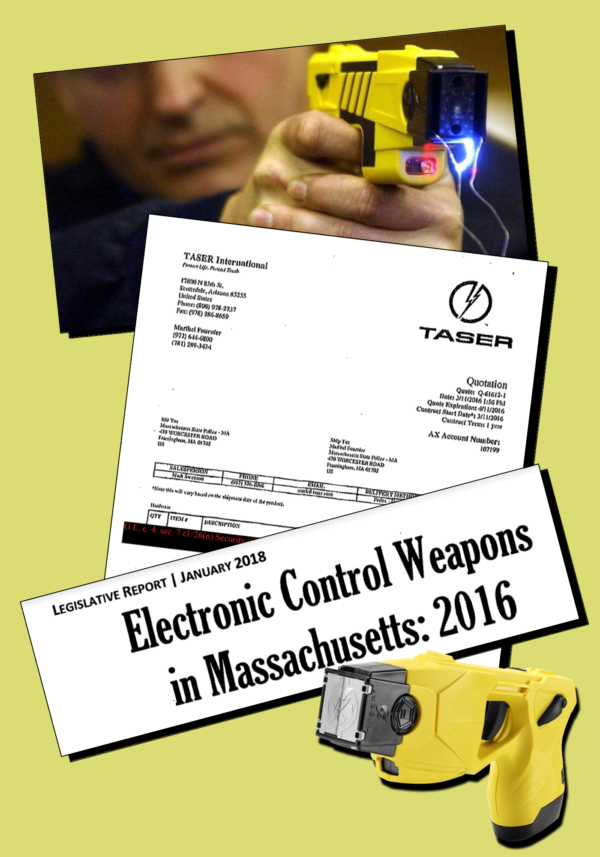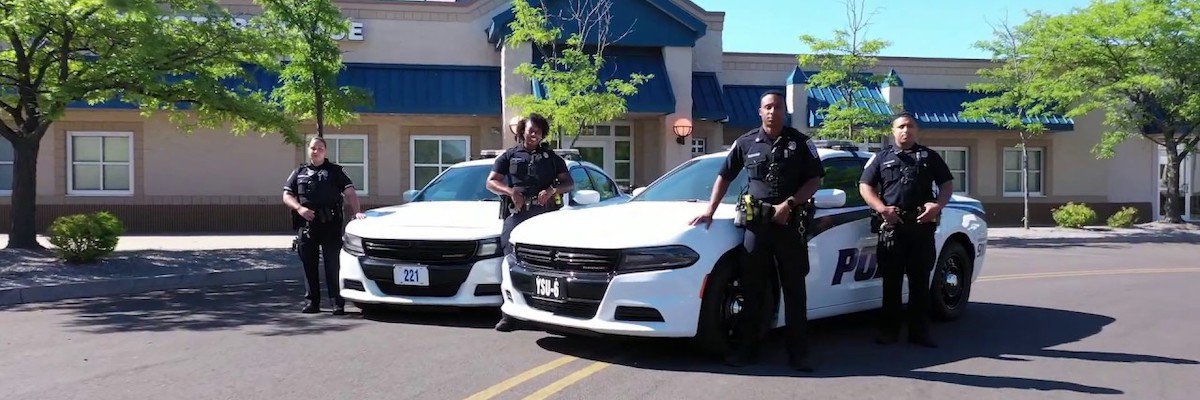This story is part of a multipart collaboration on weapons use and procurement in Massachusetts by the Boston Institute for Nonprofit Journalism, Emerson College’s Department of Journalism, MuckRock, and the Engagement Lab. Support for this story was made possible by the Online News Association’s Journalism Education Challenge Grant. To read more about the project, please visit binjonline.org.
Depending on the person doing the explaining, the story of expanding stun gun use by cops in Massachusetts is either emphatically positive, with wayward perpetrators spared from bullet-ridden endings by restrained and gracious law enforcement officers, or the most harrowing development since pepper spray and far more painful for those on the receiving end of the blast.
Ask people who have been shocked how they feel about year-over-year jumps in the deployment of stun guns, and many will describe the nightmare of having a dart probed underneath their skin, followed by a surge of electricity pumped through them as they lost control of mind, body, and muscle.
On the other side, ask those who are tasked with administering shocks, or companies that hock electronic control weapons (ECW), and you will probably hear one of the defensive arguments that ECW proponents push on their communities through friendly and complicit media - like in 2013, when police in Stoughton used a Taser-brand stun gun to break up a brawl at a baby shower.
“This officer showed significant restraint going to the Taser instead of their firearms,” Stoughton Executive Officer Robert Devine told reporters, adding, “The vast majority of the time the Taser gets removed from the holster and turned on, people just give up and that’s the whole point of it.”
In reality, according to a Massachusetts Executive Office of Public Safety and Security analysis of data from 2016 (the most recent statewide numbers that have been collected and crunched by the EOPSS), of the 1,328 ECW contacts with human subjects that year, approximately 12 percent began with the officer issuing no warning at all. Of those who were reportedly warned, less than half submitted. The rest were shocked or worse.
No two tasings are the same, and many variables apply when measuring use and impact. Semantics are important: There is the all-encompassing label of “incidents,” which, according to EOPSS, constitute events “in which an officer (or group of officers) issue a warning and/or deploy an ECW.” Incident totals may include all displays of “warning arcs,” which Taser advertises “may deter a subject without having to use actual force.” Then there is “stun deployment,” defined by the Commonwealth as “the act of bringing the ECW device into direct contact with the subject’s skin or clothing,” and “probe deployment,” the “act of firing two small dart-like probes … which attach to the subject.” Probes can be followed by an optional “5-second electrical cycle” or several repeated cycles.
With more than a thousand ECW incidents recorded by law enforcement officers across Massachusetts every year since 2015, and with that number climbing, civil liberties crusaders and defense attorneys have attempted to spark awareness about stun gun proliferation. Still, the prevailing sentiment in the press, and resultantly among the public, remains, as a 2014 piece in the Patriot-Ledger newspaper paraphrased, that “the prevalence of Tasers in movies, TV and the news has served to educate the public on the power of the shock. Just displaying a Taser often prompts criminals [to] stand down.”
Such observations and assumptions aside, a growing number of reports and studies have raised empirical criticisms. As Reuters found in an investigation published last year, “Nearly a third of the U.S. population is at higher risk of death or injury from Taser shocks—the elderly, the pregnant, those with heart conditions and more. Yet time and again … police continue to fire their stun guns at the vulnerable.” Another recent study bucks the notion that it’s harmless for a cop to simply display an ECW. According to University of Cambridge researchers in the United Kingdom, their “experiment with City of London police found that, while rarely deployed, just the presence of electroshock devices led to greater overall hostility in police-public interactions—an example of what researchers call the ‘weapons effect’.”
Since the beginning of last year, our team at the Boston Institute for Nonprofit Journalism (BINJ) has examined hundreds of state purchasing agreements, for everything from body armor and silencers to stun guns. In our research we have found that Massachusetts agencies are spending millions more than they’re allotted for various weapons and that there is little to no oversight of most of those purchases beyond the procuring departments.
Stun guns are a shocking case in point, with a single manufacturer supplying every law enforcement agency in Massachusetts that uses ECWs, and there are several trends, seemingly related, that warrant attention. Namely, as an increasing number of cops acquire Tasers, and as entities from small towns up to state police increase ECW spending, more and more people are getting tased.
Municipalities don’t collect information on the medical conditions of the people they tase, but certain data suggests vulnerable populations are encountering stun guns in Massachusetts; according to EOPSS, individuals younger than 20 years of age represented 6.7 percent of subjects tased in 2016, while individuals 60 years of age or older represented 1.5 percent. Furthermore, relative to the Massachusetts population, the subjects are disproportionately people of color.
If Bay Staters really are getting their info on stun guns from television crime shows and the evening news, as many who remain enthusiastic about ECW expansion allege, there is a lot they’re missing.
Killing them safely
With police having used stun guns across the country for decades, there have been many high-profile cases in which an electronic control weapon was deployed, and the individual who got shocked wound up with serious injuries or dying. An incident that took place in Kansas City in 2014, and was covered in detail by the Intercept, among other national outlets, displayed the brutality of an extreme deployment via dashcam video. In it, a 17-year-old pulled over at a traffic stop is tased for an excruciating 23 seconds, then handcuffed, dragged behind his car, and dropped onto the ground as he went into cardiac arrest.
The number of people who have been killed by stun guns in the U.S. is up for debate, with more conservative estimates at around 500 and a group called Truth Not Tasers putting the tally well over 1,000. What’s up for less debate is that stun guns can be lethal in some situations. According to a comprehensive 2014 survey by Dr. Douglas P. Zipes of the Indiana University School of Medicine titled “TASER Electronic Control Devices Can Cause Cardiac Arrest in Humans,” “animal and clinical data clearly support the conclusion that a TASER X26 shock can produce [the cardiac rhythm disturbance ventricular fibrillation].” Zipes concludes, “Although the risk may be low, its number cannot be known without universal record keeping and the creation of a national database.”

In Massachusetts, there have reportedly been four deaths in cases where police deployed stun guns. One happened last Dec. 27, when Erich Stelzer, a bodybuilder whose family says he suffered from “an unspecified mental illness,” died after police in Cohasset tased him to stop his violent attack on a Tinder date. At least two of the other victims were also said to have severe behavioral disorders. In 2014, a Chelsea police officer tased Dominic Graffeo, a repeat offender causing a violent disturbance. Graffeo reportedly turned purple, perhaps in part due to an overdose, and died soon after. The following year, as surveillance video shows, Worcester police tased a man named Wilmer Delgado Soba who was running around a bodega in his underwear. He was pronounced dead 15 hours later.
Another perp died after a Taser deployment in 2016. While serving a warrant in Fall River, police there stunned Scott Macomber, a friend of the person they were looking for. He died in custody, but a subsequent report issued by the Bristol County district attorney “concluded the [Fall River] officers did not cause Mr. Macomber’s death or use excessive force” and found “that the use of force in this matter did not constitute criminal conduct.” Furthermore, “an autopsy performed by the Chief Medical Examiner of the Commonwealth determined the cause of death to be Cardiac Dysrhythmia due to hypertensive and atherosclerotic cardiovascular disease and that the manner of Mr. Macomber’s death was natural.” Prosecutors who reviewed the fracas even noted the concern and kindness of arresting officers, who charged that Macomber was resisting.
“In accordance with Fall River Police Department protocol,” their report reads, “an ambulance was immediately summoned even though Mr. Macomber was making no complaints of pain and was exhibiting no signs of distress.”
The impact of ECWs on specific groups and whole communities can be drastic beyond the most excessive token cases. Various effects have been thoroughly documented, by medical and legal researchers alike. A 2017 investigation by Reuters found “the public pays most of the liability bill as police describe difficulty keeping up with the manufacturer’s increasingly detailed safety alerts.” Though the company has sharpened its training language over the years, coinciding with a trend of plaintiffs “suing governments, not the manufacturer,” reporters established that, “from 2004 through 2009 … [Taser] was named as a defendant in more than 40 percent of the wrongful death suits filed against local governments [nationwide].” That’s in addition to innumerable more excessive force cases in which the person who was tased survived.
Sophia H. Hall, an attorney with Lawyers for Civil Rights in Boston, says half of her cases involve officers who allegedly used force unprofessionally. Hall currently represents Terrence Coleman, a schizophrenic man who was shot dead by a Boston officer in 2016, and says she does not believe a shift from pistols to stun guns will improve relations between police and arrest subjects.
“It makes me think you’re sticking a Band-Aid on a problem without using antibiotics,” Hall says. “Taser use is still very horrific for the human body. Depending on how much you’re tased, it can be as deadly as if you were shot.”
Taser International, which rebranded as Axon in 2017, maintains that its ECWs are the “safest intermediate use of force.” The company boasts a thorough safety guide for all models and offers its own certification and training. Axon denies that its weapons pose a significant risk, but as an extra precaution for the past 10 years has advised users against deploying to the upper-chest region. In a training bulletin initially sent to ECW-certified police officers in 2009, the company instructed: “avoiding chest shots with [ECW] avoids the controversy about whether [ECW] do or do not affect the human heart.”
Axon has taken aggressive legal action to defend claims that Tasers don’t kill and even filed lawsuits against medical examiners who suggested that electric shocks contributed to deaths. In other instances, the company has advised departments whose deployments, lethal and otherwise, were under scrutiny. Medical examiners seem to have received the message. In Fall River, the death of Macomber was found to be related to dysrhythmia and cardiovascular disease, not anything to do with being stunned, while other autopsies stemming from similar scenarios list “excited delirium” as a cause of death. First identified by white coats at the McLean Asylum for the Insane in Charlestown, Mass., in 1849, the condition has been linked to “the increasing use of cocaine … methamphetamine … LSD … and PCP” and “has been cited as a cause of death for people tased while under the influence of drugs.” According to a 2018 paper in Forensic Science, Medicine and Pathology by Australian researcher Roger W. Byard, “Although the use of Tasers has been implicated in episodes of fatal excited delirium, no definite causal relationship has been proven.”
Donald E. Wilkes Jr., a University of Georgia School of Law professor and persistent critic of stun guns, has been less forgiving. In a 2016 paper titled “The Persistence of Fatal Police Taserings,” he writes:
Originally, it bears repeating, Tasers were touted as nonlethal weapons. Unlike firearms, they were not, we were assured, lethal weapons. Nowadays, however, doubtless as a result of the undeniable persistence of fatal taserings by police, Taser International and the police agencies that use Tasers no longer proclaim that Tasers are nonlethal weapons. Instead they now use an invented, conveniently ambiguous term to describe Tasers. Tasers, they claim, are “less-lethal” weapons, whatever that means. Their assertion is absurd. … there is no such thing as a weapon that is neither lethal nor nonlethal.

History of silence
After six years of failing to successfully produce a nonlethal electronic weapon that sold well, in 1999 brothers Rick and Tom Smith of Scottsdale, Arizona, hit the mark with their revolutionary M26 model Taser. As recounted in Killing Them Safely, a 2015 documentary about their business, the founding brothers openly acknowledged: “If we weren’t going to have a tool that can stop an individual, we weren’t going to be successful. [The M26] could stop a motivated individual.”
To demonstrate the strength of their product, the Smiths devised a simple sales pitch for potential law enforcement customers: Bring your toughest guy, and we will drop them to the ground.
According to court documents from various cases involving Taser International, in developing enhanced devices in the ’90s, the company conducted product testing on animals, discharging electrical weapons on pigs and increasing the charge deployed until there was significant muscle activity. Through these and other experiments, the company eventually determined the ideal electrical output needed to affect human motor function.
Asked about this history, Mark Swenson, a senior regional sales manager for Axon who sells Taser equipment to law enforcement agencies in Mass., explained that with minimal exceptions, the company no longer engages in such practices: “We don’t test on animals. … Our subjects are exclusively human volunteers. … I have heard of tests on bears in Alaska, because in Alaska there are a lot of bears so people will use Taser devices on bears. So there have been people who try to figure out how to deal with that, but we don’t typically use animals to test our products.”
As for ECWs that can stop a bear in its tracks and are carried by several thousand cops and troopers across Mass., according to Swenson, “the voltage is about 50,000, which sounds scary, but voltage is basically the arc that pushes the electricity to move. The amplitude, which is the electricity that’s shocking you, is about three to four milliamps. That’s like what’s in an LED light bulb in a Christmas tree.”
In Massachusetts, officers have wielded stun guns since 2004, when then-Gov. Mitt Romney hailed them as a “modern billy club” and set up the process through which departments could start training officers. Even as crime went down across the state over the following years, Taser purchasing went up, with departments arguing that increased stun gun acquisition would lead to a decrease in police shootings. When the number of shootings by state troopers and officers climbed anyway, Taser acquisition continued.
According to a report from the U.S. Bureau of Justice Statistics, nationwide, “The number of local police departments authorizing the use of Tasers and stun guns increased more than tenfold between 2000 and 2013—up from 7 percent to 81 percent.” Massachusetts has followed the trend. An EOPSS “Electronic Control Weapons in Massachusetts” report released last March shows that “During 2016, twenty police departments were approved for … (ECW) use, bringing the cumulative total to 250 (ECW) approved agencies in Massachusetts”—up from 230 the year before. Across the Commonwealth, the overall number of stun guns in law enforcement arsenals rose from 1,656 in 2011 to 6,008 in 2016, while the number of annual ECW incidents grew from 521 to 1,241 over that same period.
As for who got tased, according to EOPSS, “Black subjects experienced the greatest likelihood of weapon deployment (58.2%) followed by Hispanic subjects (52.1%),” meaning those groups had the highest chance of being stunned or probed in the event that an ECW was introduced.

Full deployment
MSP adopted Tasers for wide use relatively late in the game, issuing a press statement in March 2016 announcing that “895 ECW units have been assigned with members of the State Police Division of Field Services, who will [begin] carrying them immediately.” The release noted, “The distribution is the first time that patrol troopers are being equipped with ECW. Prior to this deployment, only members of the State Police Special Tactical Operations (STOP) Team were assigned ECWs.”
By that time, state police were already on the way to becoming Axon’s top client in Massachusetts. Though MSP attorneys redacted descriptions and amounts from hundreds of pages of purchase orders and other documents they returned in response to Freedom of Information Act requests made for this story, BINJ was able to ascertain that over the past four and a half years, the department has spent in excess of $3 million on Taser ECWs and related consumables and accessories. Some of those purchases were made through a long-term contract that began in September 2014 and is open through 2020, while others have come from subsequent multiyear purchasing programs that Swenson, the Axon sales manager, describes as “the ‘full deployment,’ which provides every field officer with a Taser device.”
MSP buyers apparently had a vendor in mind from the get-go. The department announced its request for response on Aug. 27, 2014, and in it listed items that are sold exclusively by Taser International. Taser wound up being the sole bidder and submitted a signed contract to the state four days before the due date for responses. On Sept. 22, 2014, its proposal to provide “Taser equipment, maintenance and accessories” manifested in a deal to sell a thousand devices plus twice that many replacement cartridges for a total of nearly a million dollars to state police.
In the process, MSP allowed Taser to adjust the state’s standard contractor indemnity clause to read: “This … liability obligation does not apply to any claim arising out of the deployment, use, or misuse of the Taser product by the State, its employees or agents, including any claims for damages and personal injuries. The State agrees to assume all risks of loss and all liability for any damages and personal injury which may result from the deployment use, or misuse of the Taser product.”
In 2017, MSP faced public scrutiny in response to data that showed that the department saw a 93 percent increase in use of force reports from 2015 to 2016, with 402 total recorded incidents in the latter. At the time, MSP Spokesman David Procopio blamed the way that Taser use is tallied; though only 25 state police ECW uses involved actual contact that year, by state standards, 130 counted as deployments, the residual 105 stemming from times that troopers issued warnings but no shocks. “Because of the industry standards of how use of force … is categorized,” Procopio told WBUR, “the number of times we deployed an ECW can be misleading.”
Since more recent use of force numbers have not yet been made public, BINJ filed a records request to see how often state police are deploying ECWs and against whom. According to documents obtained for this story, in the first half of 2018, troopers were involved in 52 ECW incidents. Though people who identify as black or Latino make up approximately 20 percent of the state’s population combined, they accounted for 27, or just over half, of those deployments.
Shocker
As Taser’s business with the Commonwealth and its cities and towns began to run into the million-dollar range, the amount the company spent on lobbying started to hit six figures. In 2015, Taser spent $102,000 retaining Rasky Baerlein Strategic Communications, which was paid to provide services related to “Massachusetts government relations regarding public safety.” Additionally, in 2015 and 2016, Taser paid another firm, Lynch Associates, more than $100,000 for “relationship development in the Public Safety sector.”
In terms of the potential for peddling political influence, Taser apparently made prudent choices. In Lynch, it picked a firm that also happened to be lobbying for Taser’s biggest Massachusetts client, the state police. In Rasky, it was assigned a lobbyist who has personally given more than $30,000 to campaigns in Massachusetts over the past 10 years, with gifts having gone to pols ranging from House Speaker Robert DeLeo to Gov. Charlie Baker. And that’s just at the state level.

In municipalities and counties from the Berkshires to Cape Cod, Tasers are becoming increasingly commonplace. Based on data that departments are required to submit to Massachusetts every year, BINJ solicited additional information from police departments with above-average ECW use - Barnstable, Brockton, Lawrence, New Bedford, Plymouth, Wareham, Worcester, Westfield, and Taunton. With the exception of Brockton, New Bedford, Westfield, and Wareham, none of the departments returned the details or metadata we requested. Some did not even acknowledge our inquiry.
Without help from those departments, BINJ was still able to ascertain that in certain jurisdictions, including some where cops are among the most likely in Massachusetts to use an ECW, police are still packing the Taser X26 model. According to multiple studies and the aforementioned Reuters investigation, that design presents a “higher cardiac risk” than others. Taser stopped selling the X26 in the U.S. in 2014; still, police in cities, including New Bedford and Worcester, appear to be using them.
We also found that there is zero oversight of Taser acquisitions—not at the state level for MSP or Department of Correction purchases, nor in municipalities. As for rules that govern their use, in order for a law enforcement agency to obtain ECW permission, it must first submit an application to the Secretary of Public Safety and Security and wait three to four weeks for approval. No public input is required; rather, police departments have to simply file an [ECW] “training curriculum.” That can either come from the state’s Municipal Police Training Committee (MPTC) or directly from Axon. As the only show in town that provides electronic firepower, it even offers and assists with lesson plans and departmental policies upon request.
Whether those departments follow their adopted guidelines, and keep members of the public informed about incidents and purchasing decisions involving electronic control weapons, is another story altogether.




